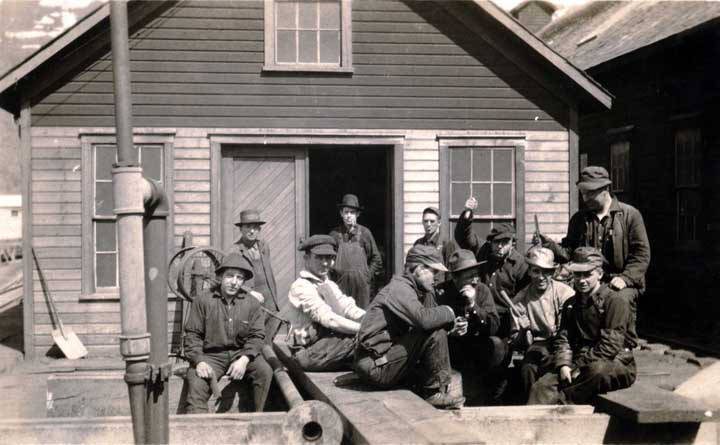On April 22, we commemorate the centenary of the Treadwell Mine cave-in that precipitated the closing of the world-famous mining complex on Douglas Island.
The Treadwell (1882-1922) was Alaska’s first successful large-scale development project and included four contiguous mines: The Treadwell, 700-Foot, Mexican, and Ready Bullion.
During its peak years, the Treadwell was the largest gold mining operation in existence and was foundational in the development of the economy and community of Juneau.
Fueled by abundant hydropower, the mines ran 24 hours a day, seven days a week, except for Christmas and the Fourth of July. Miners worked above and below ground to supply five mills with 5,000 tons of ore daily — a world record at that time.
After the gold was removed from the crushed rock, a slurry of water and waste rock traveled in tailings pipelines from the mills to the rocky shore below. Today, the full expanse of the massive operation is revealed at low tide in some 80 acres of manufactured beach that stretches for nearly two miles along Gastineau Channel,
Anchored firmly in the sand and still standing sentinel on the sprawling beach is the mine’s recently re-roofed Salt Water Pump House that provided water for fire protection and milling.
The April 22, 1917, cave-in of the Treadwell Mine merited front page headlines in newspapers around the country. “Big Mine Loss in Alaska” (Washington Post); “Rich Alaskan Mines Put Out of Operation” (Arizona Republic); “One May Be Dead in Treadwell Disaster” (Oregon Daily Journal); “Mines Are Wrecked” (Seattle Star); “Ocean Swallows Up Alaska Gold Mines” (Ithaca Journal).
[Douglas marks 100-year anniversary of Treadwell Mine cave-in]
Published accounts of the disaster noted that:
“A surface cave in, along a fault, into an enormous worked-out stope, which let the waters of Gastineau Channel into the lower workings, forced the abandonment of the Alaska Treadwell at midnight last night.”
A geologic study of the site had revealed a fault line that intersected some of the underground workings. This, coupled with the instability of the mined-out underground rock pillars and an extreme high tide, resulted in the failure of the mine structures that led to the collapse. Signs of trouble had been noticed years earlier.
The ground was actively moving in February 1917 but quieted until April 4 when cracks appeared around the Natatorium (swimming pool). On April 20, when carpenters were repairing the Natatorium from earlier ground movement, the surface around the building began to drop rapidly.
On the evening of April 21, water in the Natatorium began disappearing. At 11:00 p.m., a worker leaving the Treadwell Club heard rushing water and discovered a creek pouring into a hole 15 feet wide and 30 feet deep. A rising, and unusually high tide from Gastineau Channel added to the torrent and at 11:15 p.m., the alarm was sounded to evacuate the mines.
Two hours after the alarm was given, 350 underground miners were safely on the surface. One miner was unaccounted for. In less than four hours, tide-driven waters filled the Treadwell, 700-Foot and Mexican mines. The Ready Bullion was the only mine saved due to a new concrete bulkhead in the tunnel connecting it to the Mexican Mine. Approximately 45 miles of the mines’ 60 miles of tunnels were flooded in the disaster.
Of the 1,000 men employed in the four mines on April 21, only the 150 who had worked at the Ready Bullion kept their jobs. Many of the married men were transferred to other Treadwell departments that were still operating, including the machine shop and the foundry, and some were given jobs at the Alaska Juneau Mine. Within a few days, 500 men found work but most single miners moved away. The big 240, 300, and 700-stamp mills were torn down after the cave-in. The Mexican mill continued to process ore from the Ready Bullion until it closed in 1922.
In her book “Treadwell Gold,” Sheila Kelly references an eye-witness account of the cave-in:
“At one fifteen a.m., the small group standing vigil watched as the ground around the natatorium and fire hall slipped sideways, then with ‘cracks, groans, and noises of shattering boards’ dropped straight down into the innards of the mine.
“Finally, at two fifteen a.m., after another eruption at the cave-in site, a two-hundred-foot geyser of saltwater shot out of the top of the central shaft. The spouting display went on for a full five minutes before it stopped, like fireworks announcing a finale. After a harrowing three and a half hours, the mine was full. In those forty-five miles of mine shafts and drifts underlying the town to a depth of twenty-three hundred feet, those ancient geologic pockets that gave up ten million tons of gold-bearing ore were filled with three million tons of seawater.”
• Paulette Simpson is the chair of the Treadwell Historic Preservation & Restoration Society.

